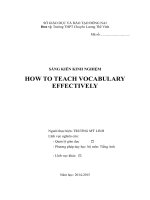- Trang chủ >>
- Mầm non - Tiểu học >>
- Lớp 1
game to teach vocabulary
Bạn đang xem bản rút gọn của tài liệu. Xem và tải ngay bản đầy đủ của tài liệu tại đây (1.3 MB, 50 trang )
<span class='text_page_counter'>(1)</span><div class='page_container' data-page=1>
Module:
Vocabulary
Facilitated By:
Cheryl Harvey
and
Rebecca Radicchi
</div>
<span class='text_page_counter'>(2)</span><div class='page_container' data-page=2></div>
<span class='text_page_counter'>(3)</span><div class='page_container' data-page=3>
<b>How confident do you feel about </b>
<b>your vocabulary instruction?</b>
<b><sub>On a scale of 1 – 9, how confident are </sub></b>
<b>you about your vocabulary instruction?</b>
<b>Place a post-it on the scale on the wall– </b>
<b>1 is the lowest & 9 is the highest.</b>
1
5
9
</div>
<span class='text_page_counter'>(4)</span><div class='page_container' data-page=4>
<b>Essential Questions:</b>
<b>Why is vocabulary instruction so </b>
<b>important?</b>
<b>What are exemplary </b>
</div>
<span class='text_page_counter'>(5)</span><div class='page_container' data-page=5>
<b>A little boy was in a relative’s wedding. </b>
<b>As he was walking down the aisle, he </b>
<b>would take two steps, stop, and turn to </b>
<b>the crowd. While facing the crowd, he </b>
<b>would put his hands up like claws and </b>
<b>roar. So it went, step, step, ROAR, step, </b>
<b>step, ROAR, all the way down the aisle. </b>
<b>As you can imagine, the crowd was near </b>
<b>tears from laughing so hard. The little boy </b>
<b>was getting more and more distressed </b>
<b>from all the laughing, and he was also </b>
<b>near tears. When asked what he was </b>
<b>doing, the child sniffed and said, “I was </b>
</div>
<span class='text_page_counter'>(6)</span><div class='page_container' data-page=6>
<b>LEVEL 1</b>
<b> Unknown</b>
<b>LEVEL 2</b>
<b> Acquainted</b>
<b>LEVEL 3</b>
<b> Established</b>
Beck, McKeown, & Omanson, 1987
<b>What level of</b>
<b>vocabulary knowledge is </b>
</div>
<span class='text_page_counter'>(7)</span><div class='page_container' data-page=7>
•
<b><sub>Discuss your </sub></b>
<b>response with a </b>
<b>partner. </b>
•
<b><sub>Group leader should </sub></b>
<b>be prepared to share </b>
<b>with everyone.</b>
</div>
<span class='text_page_counter'>(8)</span><div class='page_container' data-page=8>
<b>Word knowledge is much more than </b>
<b>word identification or even definitional </b>
<b>knowledge–</b>
<i><b>“It takes more than definitional </b></i>
<i><b>knowledge to know a word, and we have </b></i>
<i><b>to know words in order to identify them </b></i>
<i><b>in multiple reading and listening </b></i>
</div>
<span class='text_page_counter'>(9)</span><div class='page_container' data-page=9>
<b>There is an </b>
<b>estimated 4,700 </b>
<b>word difference in </b>
<b>vocabulary </b>
<b>knowledge </b>
<b>between high- and </b>
<b>low- SES. (Nagy and </b>
<b>Herman ,1984) </b>
<b>Research on the importance of </b>
<b>vocabulary instruction:</b>
<b>For English </b>
<b>language learners </b>
<b>the “achievement </b>
<b>gap” is primarily a </b>
<b>vocabulary gap. </b>
<b>(Carlo, et.al., 2004)</b>
<b>Vocabulary </b>
<b>instruction is one </b>
<b>of the essential </b>
<b>elements for </b>
<b>literacy </b>
<b>development for </b>
<b>students “at risk.”</b> (
RAND Reading Study Group, 2002,
</div>
<span class='text_page_counter'>(10)</span><div class='page_container' data-page=10>
<b>Word Knowledge is Multifaceted</b>
<b>Know it </b>
<b>well, can </b>
<b>explain it, </b>
<b>use it</b>
<b>Know </b>
<b>something </b>
<b>about it, can </b>
<b>relate it to a </b>
<b>situation</b>
<b>Have seen or </b>
<b>heard of the </b>
<b>word</b>
<b>Do not know </b>
<b>the word</b>
<b>schema</b>
<b>prosody</b>
<b>morpheme</b>
<b>schwa</b>
<b>automaticity</b>
<b>diphthong</b>
</div>
<span class='text_page_counter'>(11)</span><div class='page_container' data-page=11>
<b>Comprehensive Vocabulary </b>
<b>Instruction</b>
<b><sub>Rich language learning environment </sub></b>
<b>( including Read-Alouds)</b>
• Wide and Varied
Independent Reading
</div>
<span class='text_page_counter'>(12)</span><div class='page_container' data-page=12>
<b>Reading Aloud</b>
•
<b><sub>Students retain more vocabulary </sub></b>
<b>when the teacher explains critical </b>
<b>vocabulary terms in context </b>
<b>during the reading. </b>
•
<b><sub>Reading a book several times </sub></b>
</div>
<span class='text_page_counter'>(13)</span><div class='page_container' data-page=13>
<b>Reading Aloud</b>
"
<i><b>The single most important </b></i>
<i><b>activity for building the </b></i>
<i><b>knowledge required for </b></i>
<i><b>eventual success in </b></i>
<i><b>reading is reading aloud </b></i>
<i><b>to children."</b></i>
</div>
<span class='text_page_counter'>(14)</span><div class='page_container' data-page=14>
<b>Collaborative Pairs</b>
•
<b><sub>What are the advantages of </sub></b>
<b>reading aloud to students?</b>
<b> </b>
•
<b><sub>How do read-alouds support </sub></b>
</div>
<span class='text_page_counter'>(15)</span><div class='page_container' data-page=15>
<b>Comprehensive Vocabulary </b>
<b>Instruction</b>
• <b><sub>Rich language learning environment </sub></b>
<b>(including Read-Alouds)</b>
<b><sub>Wide and Varied Independent </sub></b>
<b>Reading</b>
</div>
<span class='text_page_counter'>(16)</span><div class='page_container' data-page=16>
<b>Reading Volume of 5th-grade Students of </b>
<b>Different Levels of Achievement</b>
<b>Achievement</b>
<b>Percentile</b>
<b>Minutes of</b>
<b>Reading Per </b>
<b>Day</b>
<b>Words</b>
<b>Per</b>
<b>Year</b>
90th 40.4 2,357,000
50th 12.9 601,000
10th 1.6 51,000
</div>
<span class='text_page_counter'>(17)</span><div class='page_container' data-page=17>
<b>Independent Reading: </b>
<b>Accounts for one-third or more of </b>
<b>vocabulary growth.</b>
• <b><sub>How do you show your </sub></b>
<b>students that independent </b>
<b>reading is great & joyful? </b>
• <b><sub>How do you make </sub></b>
<b>independent reading </b>
<b>time meaningful?</b>
• <b><sub>What obstacles do you </sub></b>
<b>need to overcome?</b>
</div>
<span class='text_page_counter'>(18)</span><div class='page_container' data-page=18>
<b>Comprehensive Vocabulary </b>
<b>Instruction</b>
• <b>Rich language learning </b>
<b>environment </b>
<b>( including </b>
<b>Read-Alouds)</b>
• <b><sub>Wide and Varied </sub></b>
<b>Independent Reading</b>
<b>Direct Vocabulary </b>
</div>
<span class='text_page_counter'>(19)</span><div class='page_container' data-page=19>
<b>Vocabulary Instruction</b>
<b>Direct teaching of vocabulary can help improve comprehension when we follow </b>
<b>these guidelines (Cooper, 1993):</b>
•
<b><sub>A few critical words are taught.</sub></b>
•
<b><sub>The words are taught in a meaningful </sub></b>
<b>context. (including nonlinguistic </b>
<b>representations)</b>
•
<b><sub>Students relate the new words to their </sub></b>
<b>background knowledge.</b>
•
<b><sub>Students are exposed to the words </sub></b>
</div>
<span class='text_page_counter'>(20)</span><div class='page_container' data-page=20></div>
<span class='text_page_counter'>(21)</span><div class='page_container' data-page=21>
<b>You Try It!</b>
•
<b><sub>Using the text provided, collaborate </sub></b>
<b>with group members and decide on </b>
<b>the most important words to teach.</b>
</div>
<span class='text_page_counter'>(22)</span><div class='page_container' data-page=22>
<b>“Which words should I teach?”</b>
• <b><sub>Which words are most important to </sub></b>
<b>understanding the text?</b>
• <b><sub>How much prior knowledge will students </sub></b>
<b>have about the word/concept?</b>
• <b><sub>Is the concept significant and therefore </sub></b>
<b>requires previewing?</b>
• <b><sub>Which words can be figured out from the </sub></b>
<b>context?</b>
</div>
<span class='text_page_counter'>(23)</span><div class='page_container' data-page=23></div>
<span class='text_page_counter'>(24)</span><div class='page_container' data-page=24></div>
<span class='text_page_counter'>(25)</span><div class='page_container' data-page=25>
<b>Background Knowledge</b>
<b>“The relationship </b>
<b>between vocabulary </b>
<b>knowledge and </b>
<b>background </b>
<b>knowledge is </b>
<b>explicit in research.</b>
<b>”</b>
</div>
<span class='text_page_counter'>(26)</span><div class='page_container' data-page=26>
<b>Powerful Zebras</b>
</div>
<span class='text_page_counter'>(27)</span><div class='page_container' data-page=27>
<b>Word Sorts</b>
• <b><sub>Provide students with a set of vocabulary </sub></b>
<b>word cards (related to a specific concept or </b>
<b>topic).</b>
• <b><sub>Work in groups to sort the words into </sub></b>
<b>categories.</b>
• <b><sub>Encourage students to find more than one </sub></b>
<b>category for the vocabulary words.</b>
• <b><sub>Students then discuss with teacher & peers </sub></b>
<b>their rationale for categorizing words.</b>
<b>cold fro<sub>nt</sub></b>
<b>meteorologist</b>
<b>temperature</b>
<b>barom</b>
<b>eter</b>
</div>
<span class='text_page_counter'>(28)</span><div class='page_container' data-page=28>
<b>migrate</b>
Schwartz & Raphael, 1985
<b>To move regularly from one </b>
<b>region to another</b>
<b>people working </b>
<b>for seasonal jobs</b> <b>birds </b> <b>Nomads</b>
<b>traveling</b>
<b>relocating</b>
<b>moving around</b>
<b>What are some examples?</b>
</div>
<span class='text_page_counter'>(29)</span><div class='page_container' data-page=29>
<b>Definition</b> <b>Characteristics</b>
<b>Non-Examples</b>
<b>Examples</b>
<b>Frayer Model </b>
<b>(Frayer, Frederick, & Klausmeier, 1969)</b>
<b>herd</b>
• <b>Group</b>
•<b> Like animals</b>
•<b> Clustered</b>
<b>a congregation of wild </b>
</div>
<span class='text_page_counter'>(30)</span><div class='page_container' data-page=30>
<b>Definition</b> <b>Characteristics</b>
<b>Non-Examples</b>
<b>Examples</b>
<b>Frayer Model </b>
<b>(Frayer, Frederick, & Klausmeier, 1969)</b>
<b>Prime</b>
<b>2, 3, 5, 7, 11, 13, </b>
<b>17, . . .</b> <b>1, 4, 6, 8, 9, 10. . . </b>
• <b>2 is the only even prime number</b>
•<b> 0 and 1 are not prime</b>
•<b>Every whole number </b>
<b>can be written as a </b>
<b>product of primes</b>
<b>A whole number with </b>
</div>
<span class='text_page_counter'>(31)</span><div class='page_container' data-page=31></div>
<span class='text_page_counter'>(32)</span><div class='page_container' data-page=32>
Words Context Predicted
Definition
Confirm
Nutrition
Ballyhoo
cereal box
billboard
Important
ingredient in
food
? To advertise <sub>in loud </sub>
</div>
<span class='text_page_counter'>(33)</span><div class='page_container' data-page=33>
<b>MATHEMATICS</b>
<b>NAME</b> <b>SYMBOL</b> <b>LABEL</b> <b>KEY WORD</b> <b>DEFINITION </b>
<b>(OWN WORDS)</b>
Plane
<b>.B</b>
<b>.A</b> <b>.C</b>
2-D or Flat A plane is a flat <sub>surface like the </sub>
top of my desk.
Point <b>.</b> <b><sub>.M</sub></b> Dot
A point has no
dimension, just a
location. Group
together to make
lines.
Line
<b> .</b>
<b>K</b><b> .</b>
<b>L</b> StraightA line is a set of
points determined
by any 2 points.
Line Segment
</div>
<span class='text_page_counter'>(34)</span><div class='page_container' data-page=34>
<b>Reading with Word Explanation</b>
• <b><sub>Read the book/text once with minimal </sub></b>
<b>explanation.</b>
• <b>After an initial reading, we can interrupt </b>
<b>up to 8-10 times to explain words while </b>
<b>rereading (possibly less, depending on </b>
<b>length)</b>
• <b>With very young children, don’t interrupt </b>
<b>more than once per page.</b>
• <b><sub>Keep explanations </sub></b><i><b><sub>simple</sub></b></i><b><sub>~ explain only </sub></b>
</div>
<span class='text_page_counter'>(35)</span><div class='page_container' data-page=35></div>
<span class='text_page_counter'>(36)</span><div class='page_container' data-page=36>
<b>Four Square Response</b>
<b>Term</b> <b>Illustration</b>
<b>Definition</b>
<i><b>a degree of wetness </b></i>
<i><b>especially of the atmosphere</b></i>
<b>Connection</b>
</div>
<span class='text_page_counter'>(37)</span><div class='page_container' data-page=37>
<b>Concept Circles</b>
<b>Why? ___________________________________________________</b>
<b>Which word does </b>
<b>not belong?</b>
<b>Cone</b>
<b>Rectangle</b>
</div>
<span class='text_page_counter'>(38)</span><div class='page_container' data-page=38>
<b>racism</b> <b><sub>stereotyping</sub></b>
<b>Church</b>
<b>bombing</b> <b>violence</b>
</div>
<span class='text_page_counter'>(39)</span><div class='page_container' data-page=39>
<b>Vocabulary Strategies for ELL</b>
• <b><sub>Preview texts for unfamiliar or difficult </sub></b>
<b>words and the use of idiomatic language. </b>
<b>To reduce students’ frustration, such </b>
<b>words and expressions can be taught </b>
<b>prior to the lesson.</b>
• <b><sub>Use extensive modeling and visual </sub></b>
<b>representations– e.g., pantomime, graphic </b>
<b>organizers, pictures, hands-on materials.</b>
• <b><sub>Emphasize meaning rather than </sub></b>
</div>
<span class='text_page_counter'>(40)</span><div class='page_container' data-page=40>
<b>4-2-1 Summarizer</b>
<b>Four</b>
<b><sub>Two</sub></b>
<b><sub>One</sub></b>
</div>
<span class='text_page_counter'>(41)</span><div class='page_container' data-page=41>
<b>Pictionary</b>
<b>Using only a piece of paper and pen, draw </b>
<b>and get your partner to say these words.</b>
<b>Los Angeles</b>
<b>New York</b>
<b>Miami</b>
</div>
<span class='text_page_counter'>(42)</span><div class='page_container' data-page=42>
<b>Assessing Vocabulary </b>
<b>Instruction</b>
•
<b><sub>Ongoing</sub></b>
•
<b><sub>Varied, Meaningful & </sub></b>
<b>Authentic</b>
<b>Use word wall</b>
•
<b><sub>Do you see them </sub></b>
</div>
<span class='text_page_counter'>(43)</span><div class='page_container' data-page=43>
How do you keep words you teach
directly fresh in their minds and
internalized?
•Vocabulary word review tub
•Center with former words
•Keep ongoing list of words with guided reading
groups
</div>
<span class='text_page_counter'>(44)</span><div class='page_container' data-page=44>
<i><b>Finding definitions and writing </b></i>
<i><b>those words in sentences have </b></i>
<i><b>had little apparent impact on </b></i>
<i><b>their word knowledge and </b></i>
<i><b>language use.</b></i>
</div>
<span class='text_page_counter'>(45)</span><div class='page_container' data-page=45>
<b>Assessing Integration</b>
<b> & Meaningful Use</b>
Sample “test” questions:
• <b>One of our target words for this week was </b>
<i><b>preposterous</b></i><b>. What kind of in-school behavior </b>
<b>would the principal think was </b><i><b>preposterous</b></i><b>?</b>
• <b>Describe a time when you felt </b><i><b>liberated</b></i><b>. What was </b>
<b>the reason for that feeling?</b>
• <b><sub>The concept we have been studying this week is </sub></b>
<i><b>stereotyping</b></i><b>? Give an example of what you think is </b>
<b>stereotypical behavior. Why do you think the </b>
</div>
<span class='text_page_counter'>(46)</span><div class='page_container' data-page=46>
<b>Dictionary </b>
<b>Use</b>
<b>When students have been provided dictionary </b>
<b>definitions and asked to create sentences </b>
<b>or answer brief questions about the words, </b>
<b>research has shown: </b>
• <b>63 percent of the students’ sentences were </b>
<b>judged to be “odd” (Miller & Gildea, 1985)</b>
• <b>60 percent of students’ responses were </b>
</div>
<span class='text_page_counter'>(47)</span><div class='page_container' data-page=47>
<b>3 x 3 Vocabulary</b>
word
knowledge
reading with
explanation
<sub>strategies</sub>
direct
instruction
Nonlinguistic
representations
Frayer
dictionaries
background
knowledge
assessment
</div>
<span class='text_page_counter'>(48)</span><div class='page_container' data-page=48>
<b>Essential Questions:</b>
<b>Why is vocabulary instruction </b>
<b>so important?</b>
<b>What are exemplary </b>
</div>
<span class='text_page_counter'>(49)</span><div class='page_container' data-page=49>
Web Resources for
Vocabulary Practice
• Vocabulary.com
• Vocabulary Builders
</div>
<span class='text_page_counter'>(50)</span><div class='page_container' data-page=50>
Resources
</div>
<!--links-->









